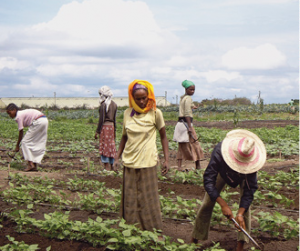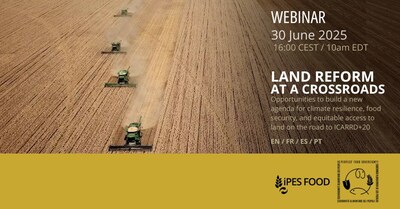Maclean's | 19 August 2010
by Nancy Macdonald
Visit a supermarket in Abu Dhabi and you’ll be greeted by row after row of picture-perfect produce, most of it imported. The Indian subcontinent has long supplied food to the wealthy desert capital. These days, though, it’s likely those rows of shiny vegetables and fruit came from an improbable source: Ethiopia, a country practically synonymous with famine. Yes, Africa, where one in three people is malnourished, is now growing tomatoes and butter lettuce for export.
Ethiopia’s biggest greenhouse farming operation is kept hidden from curious, or hungry, eyes; even in Awassa, the southern city where it’s housed, few know it exists. Two kilometres down a dusty private road, past a checkpoint guarded with AK47s, hundreds of pristine, white greenhouses suddenly appear, alien to the setting. Farming in Ethiopia is still done by sickle and ox-driven plough. But inside Awassa’s cool, humidity-controlled greenhouses, vines are fed by a computerized irrigation system, the latest Dutch agricultural technology.
Every day, a workforce of 1,000 locals pick, pack and load hundreds of tons of fresh produce onto waiting trucks, including 30 tons of tomatoes alone. After reaching the capital, Addis Ababa, the produce is flown to a handful of Middle Eastern cities, entirely bypassing Ethiopia, one of the hungriest places on the planet. The trip from vine to store shelf takes less than 24 hours. It’s the latest project by Saudi oil and mining billionaire, Sheikh Mohammed Al Amoudi. And it may be the future of farming.
Over the past 18 months, plantations like this one have been sprouting across Africa. Middle Eastern countries like Saudi Arabia—rich in oil, but water-poor—as well as those dependent on imports like South Korea and Japan, and rising powers like China and India, have begun leasing vast tracts of land in Africa, outsourcing food production to the continent. Agribusiness and Western hedge funds are funnelling billions into the new projects, banking on future scarcity.
The controversial trend has been dubbed “outsourcing’s third wave”—following manufacturing and information technology (IT) in the ’80s and ’90s. The high cost of installing irrigation systems, and importing fertilizers, combines and tractors is no deterrent. Defenders of the new projects say they’re bringing desperately needed new technologies, seeds and investment to Africa. But opponents see the trend as a “land grab” that is forcing poor farmers off their land, and benefiting only the governments inking the deals.
Already, commercial farms dot the northbound highway to Addis Ababa. In the evenings, a steady stream of trucks loaded with fat, sumptuous berries and cherry-red tomatoes rumble past, rushing to Bole International Airport and Gulf state grocery stores beyond. The highway’s dusty shoulders, meanwhile, are littered with the carcasses of animals dead from starvation and disease, the bones bleached white from the sun. The contrast is grim, even by local standards.
The new scramble for Africa was triggered by a convergence of events: surging demand for biofuels, rising consumption patterns in China and India and the 2008 global food crisis, when the price of corn and wheat tripled, almost overnight. Responding to sudden hyperinflation, rioting and panic buying, at least 30 countries, including Argentina, Vietnam, Brazil, Cambodia and India, banned or sharply reduced food exports. In short order, Japan and South Korea, who import 70 per cent of their grains, joined a parade of countries turning to Africa to lock in means of production beyond their borders.
The scale of the effort is astonishing. More than 125 million acres—an area roughly equal in size to Sweden—has been or is being negotiated for lease or sale in poorer countries, mostly in Africa, according to a recent estimate. In Sudan alone, the U.A.E. and South Korea have leased one and two million acres respectively, for crops including corn, alfalfa, potatoes and beans; Egypt has enough land there to grow two million tons of wheat annually, and Saudi Arabia and Jordan have leased 25,000 and 60,000 acres each, mainly to grow wheat and corn. In February, the U.S. investment firm BlackRock launched a world agriculture fund, earmarking US$30 million for farmland acquisitions; Goldman Sachs and Morgan Stanley already offer investors access to similar funds. Calgary’s Agcapita, a three-year-old firm focused exclusively on farmland investment, says private equity firms have lined up some US$3 billion for farmland in developing countries.
Mostly, the deals fly under the radar. Sometimes, their size or sheer audacity triggers attention—like former AIG trader Philippe Heilberg’s deal to lease one million acres in Darfur. When it emerged that Daewoo, the South Korean giant, had signed a 99-year lease granting it close to half of Madagascar’s arable land, protests broke out in Antananarivo, the country’s capital, eventually sinking both the deal, and the president.
Why Africa? Not only is land roughly one-tenth the price of land in Asia, it’s likely the “final frontier,” says Paul Christie, marketing director at Emergent Asset, a London investment firm investing several hundred million dollars in commercial farms in Africa. Some 90 per cent of the world’s arable land is thought to be in use. Also, as Heilberg told the German magazine Der Spiegel after closing the deal in Darfur, “When food becomes scarce, the investor needs a weak state that does not force him to abide by any rules.” Sudan, a dictatorship ranked among the five most corrupt countries on the planet, certainly qualifies. Heilberg’s deal was approved by the deputy commander of Sudan’s People’s Liberation Army (SPLA), the official army of semi-autonomous southern Sudan. “This is Africa,” he recently told Rolling Stone. “The whole place is like one big mafia. I’m like a mafia head. That’s the way it works.”
He’s now looking to double his Sudanese holdings. In so doing, he’ll also gain access to hundreds of million of gallons of scarce water resources—the hidden impulse behind this new play on Africa, says Michael Taylor, with the Rome-based International Land Coalition. “Saudi Arabia has no shortage of land.
Its interest in Africa,” he says, “is water.” What we tend to think of as a dry continent actually has more water resources per capita than Europe, and drought-ridden countries from the Persian Gulf to Asia want in. In places, Taylor warns, investors are walking away with two-page contracts covering 99-year leases. No matter what the harm—over-consumption of water, over-fertilization, deforestation—“governments will be powerless to make changes.” South Korea’s Sudanese plantation will draw from the Nile, threatening Egypt’s food security downstream. Already experts warn of a brewing conflict between the nine Nile states—including favourite destinations for foreign farms: Sudan, Ethiopia, Tanzania and Kenya. Can the region shoulder the added water strain?
But the land deals also offer a chance to reverse decades of under-investment in Africa—which was bypassed by the Green Revolution that, in the ’60s and ’70s, transformed India and China. In much of the poor world, “land is not primal forest,” says Oxford economist Paul Collier; “it is just badly farmed.”
Collier, among the best-known voices on global poverty, argues that the West’s “love affair with peasant agriculture” is clouding the development debate on Africa. “Our peasantry vanished for a simple reason—it was inefficient,” says the author of The Bottom Billion, pointing to emerging market successes like Brazil, where large-scale industrial farms have replaced small holdings. “Commercial farms innovate,” he writes, “because scale helps to overcome the impediments faced by the small.” Some African intellectuals bridle at Western criticism of the play on Africa. “They’re here because we want them here,” says Teshome Gabre-Mariam, one of Ethiopia’s top lawyers. “We can’t ignore the development potential of this venture. We have everything to gain, nothing to lose.”
These days the severity of the food crisis has eased, but not forever. By 2050, when the global population tips nine billion, demand for food will have risen by as much as 70 per cent, according to the UN Food and Agriculture Organization. Food commodity prices continue to climb alongside rising energy prices and desertification is accelerating from Australia to China to Spain; the rising temperatures are predicted to slash yields. In places, that’s already begun. Like it or not, hungry eyes will increasingly zero in on Africa. The world, it seems, may come to depend on it.












